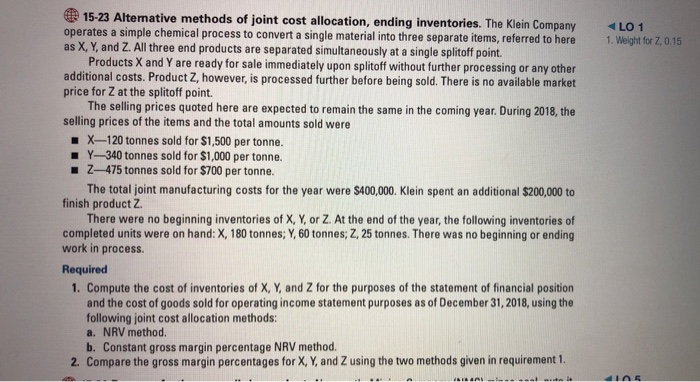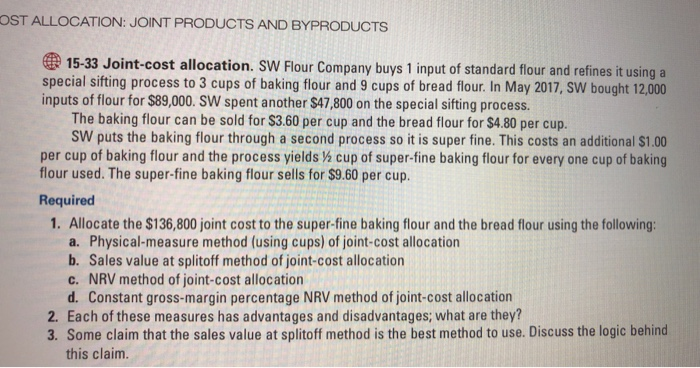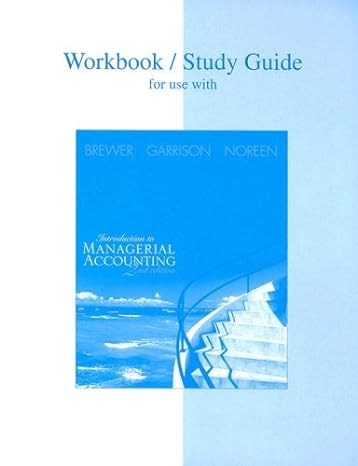Answered step by step
Verified Expert Solution
Question
1 Approved Answer
please help urgent! ps: with details please help 15-23 LO 1 1. Weight for 7.0.15 15-23 Alternative methods of joint cost allocation, ending inventories. The
please help urgent! ps: with details please 


help 15-23
LO 1 1. Weight for 7.0.15 15-23 Alternative methods of joint cost allocation, ending inventories. The Klein Company operates a simple chemical process to convert a single material into three separate items, referred to here as X, Y, and Z. All three end products are separated simultaneously at a single splitoff point. Products X and Y are ready for sale immediately upon splitoff without further processing or any other additional costs. Product Z, however, is processed further before being sold. There is no available market price for Z at the splitoff point. The selling prices quoted here are expected to remain the same in the coming year. During 2018, the selling prices of the items and the total amounts sold were X-120 tonnes sold for $1,500 per tonne. Y-340 tonnes sold for $1,000 per tonne. . 2-475 tonnes sold for $700 per tonne. The total joint manufacturing costs for the year were $400,000. Klein spent an additional $200,000 to finish product Z There were no beginning inventories of X, Y, or Z. At the end of the year, the following inventories of completed units were on hand: X, 180 tonnes; Y, 60 tonnes, Z, 25 tonnes. There was no beginning or ending work in process Required 1. Compute the cost of inventories of X, Y, and Z for the purposes of the statement of financial position and the cost of goods sold for operating income statement purposes as of December 31, 2018, using the following joint cost allocation methods: a. NRV method b. Constant gross margin percentage NRV method. 2. Compare the gross margin percentages for X, Y, and Z using the two methods given in requirement 1. BISA OST ALLOCATION: JOINT PRODUCTS AND BYPRODUCTS 15-33 Joint-cost allocation. SW Flour Company buys 1 input of standard flour and refines it using a special sifting process to 3 cups of baking flour and 9 cups of bread flour. In May 2017, SW bought 12,000 inputs of flour for $89,000. SW spent another $47,800 on the special sifting process. The baking flour can be sold for $3.60 per cup and the bread flour for $4.80 per cup. SW puts the baking flour through a second process so it is super fine. This costs an additional $1.00 per cup of baking flour and the process yields 1 cup of super-fine baking flour for every one cup of baking flour used. The super-fine baking flour sells for $9.60 per cup. Required 1. Allocate the $136,800 joint cost to the super-fine baking flour and the bread flour using the following: a. Physical measure method (using cups) of joint-cost allocation b. Sales value at splitoff method of joint-cost allocation c. NRV method of joint-cost allocation d. Constant gross-margin percentage NRV method of joint-cost allocation 2. Each of these measures has advantages and disadvantages; what are they? 3. Some claim that the sales value at splitoff method is the best method to use. Discuss the logic behind this claim. LO 1 1. Weight for 7.0.15 15-23 Alternative methods of joint cost allocation, ending inventories. The Klein Company operates a simple chemical process to convert a single material into three separate items, referred to here as X, Y, and Z. All three end products are separated simultaneously at a single splitoff point. Products X and Y are ready for sale immediately upon splitoff without further processing or any other additional costs. Product Z, however, is processed further before being sold. There is no available market price for Z at the splitoff point. The selling prices quoted here are expected to remain the same in the coming year. During 2018, the selling prices of the items and the total amounts sold were X-120 tonnes sold for $1,500 per tonne. Y-340 tonnes sold for $1,000 per tonne. . 2-475 tonnes sold for $700 per tonne. The total joint manufacturing costs for the year were $400,000. Klein spent an additional $200,000 to finish product Z There were no beginning inventories of X, Y, or Z. At the end of the year, the following inventories of completed units were on hand: X, 180 tonnes; Y, 60 tonnes, Z, 25 tonnes. There was no beginning or ending work in process Required 1. Compute the cost of inventories of X, Y, and Z for the purposes of the statement of financial position and the cost of goods sold for operating income statement purposes as of December 31, 2018, using the following joint cost allocation methods: a. NRV method b. Constant gross margin percentage NRV method. 2. Compare the gross margin percentages for X, Y, and Z using the two methods given in requirement 1. BISA OST ALLOCATION: JOINT PRODUCTS AND BYPRODUCTS 15-33 Joint-cost allocation. SW Flour Company buys 1 input of standard flour and refines it using a special sifting process to 3 cups of baking flour and 9 cups of bread flour. In May 2017, SW bought 12,000 inputs of flour for $89,000. SW spent another $47,800 on the special sifting process. The baking flour can be sold for $3.60 per cup and the bread flour for $4.80 per cup. SW puts the baking flour through a second process so it is super fine. This costs an additional $1.00 per cup of baking flour and the process yields 1 cup of super-fine baking flour for every one cup of baking flour used. The super-fine baking flour sells for $9.60 per cup. Required 1. Allocate the $136,800 joint cost to the super-fine baking flour and the bread flour using the following: a. Physical measure method (using cups) of joint-cost allocation b. Sales value at splitoff method of joint-cost allocation c. NRV method of joint-cost allocation d. Constant gross-margin percentage NRV method of joint-cost allocation 2. Each of these measures has advantages and disadvantages; what are they? 3. Some claim that the sales value at splitoff method is the best method to use. Discuss the logic behind this claim Step by Step Solution
There are 3 Steps involved in it
Step: 1

Get Instant Access to Expert-Tailored Solutions
See step-by-step solutions with expert insights and AI powered tools for academic success
Step: 2

Step: 3

Ace Your Homework with AI
Get the answers you need in no time with our AI-driven, step-by-step assistance
Get Started


